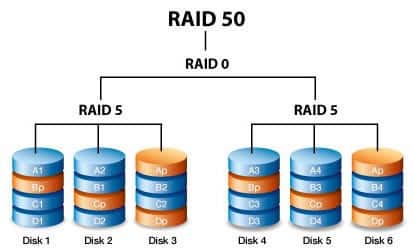RAID 50 Data Recovery
RAID 50 data recovery – Welcome to our definitive guide on RAID 50 data recovery, where we delve into the intricate workings of this complex storage architecture and explore the strategies and techniques essential for successful data recovery. Whether you’re a seasoned IT professional or a curious enthusiast, this article aims to provide you with invaluable insights into RAID 50 data recovery.

Understanding RAID 50:
RAID 50 is a nested RAID configuration that combines the features of RAID 5 and RAID 0. It offers the redundancy of RAID 5 along with the striping performance of RAID 0, making it an attractive option for organizations seeking a balance between data protection and performance. In a RAID 50 array, data is striped across multiple RAID 5 arrays, and parity information is distributed across the drives.
Challenges of RAID 50 Data Recovery:
Despite its benefits, RAID 50 data recovery presents unique challenges due to its complex architecture. When a drive in the array fails, it can compromise both data availability and integrity. Moreover, the interdependency of RAID 5 and RAID 0 within the configuration adds another layer of complexity to the recovery process.
Essential Steps for RAID 50 Data Recovery:
- Assessment and Evaluation: The first step in RAID 50 data recovery is a thorough assessment of the extent of the damage. This involves identifying failed drives, analyzing the integrity of the remaining data, and evaluating the overall health of the array.
- Reconstruction of the Array: Once the assessment is complete, the next step is to reconstruct the RAID 50 array. This typically involves rebuilding the RAID 5 arrays and restoring the striping configuration of RAID 0. Advanced software tools and specialized hardware may be required for this task.
- Parity Calculation and Regeneration: In RAID 50, parity information plays a crucial role in data recovery. During this phase, parity calculations are performed to regenerate missing data blocks and ensure data consistency across the array.
- Data Extraction and Verification: After the array is successfully reconstructed, the final step is to extract the recovered data and verify its integrity. This involves thorough testing and validation to ensure that the recovered data is accurate and complete.
Best Practices for RAID 50 Data Recovery:
- Regular Backup: Implementing a robust backup strategy is essential for mitigating the risk of data loss in RAID 50 arrays.
- Professional Assistance: In complex data recovery scenarios, seeking the expertise of professional data recovery services can significantly improve the chances of success.
- Avoid DIY Solutions: Attempting to recover data from a RAID 50 array without the necessary expertise and tools can exacerbate the problem and lead to further data loss.
RAID 50 data recovery requires a combination of technical expertise, specialized tools, and meticulous attention to detail. By understanding the intricacies of RAID 50 architecture and following best practices for data recovery, organizations can minimize the impact of data loss and ensure the integrity of their critical data assets. Whether facing a catastrophic failure or proactively planning for data recovery, investing in the right resources and expertise is key to achieving successful outcomes in RAID 50 data recovery endeavors.

